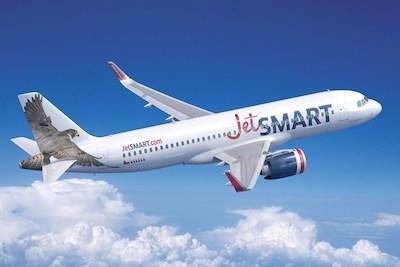Fri, Jun 28, 2019
Modern Geared Turbofan Technology Accounts For The Majority Of Orders
This year's Paris Air Show ended with an order intake of more than $1.3 billion for MTU Aero Engines. The orders for Germany's leading engine manufacturer mainly result from orders and memorandums of understanding (MoU) for the geared turbofan (GTF) engines of the PW1000G family for short- and medium-range aircraft. They account for around 95 percent of the volume during the Paris Air Show. There was also a commitment for the GEnx long-range engine, in which MTU also has a stake.

MTU's most recent orders predominantly stem from Airbus aircraft. The largest single order was placed by JetSMART with engines for 85 A320neo Family aircraft. Engines for a further 142 aircraft in this category were ordered by several undisclosed customers. The Mexican airline Viva Aerobus opted for the GTF for 41 A321neo aircraft. In addition, SMBC Aviation Capital and Aviation Capital Group each ordered 20 aircraft from this family. The engine selection for the A321XLR long-haul version presented at the Paris Air Show are largely still pending. Only the four aircraft for Middle East Airlines already have GTF engines. The commitments from Air Lease for 50, from Nordic Aviation Capital for 20 and from Delta Airlines for 5 A220 aircraft further strengthen MTU's order intake. Through its share in the GEnx program, MTU benefits from the orders for the Boeing 787. Korean Air opted for 30 aircraft of this type.
“Modern and efficient engines determine MTU's future in the commercial engine business,” says MTU CEO Reiner Winkler, commenting on the order influx. “This is demonstrated at the Paris Air Show by the continued success of the geared turbofan family and the GEnx engine. While we are mastering the ramp-up of these programs, we are also working on the long-term technological prospects for sustainable aviation,” Winkler continued.
MTU is simultaneously researching evolutionary approaches that can already be operated with sustainable fuels (eFuels), as well as alternative propulsion concepts such as hybrid-electric flying and fuel cells. The second generation of GTFs still offers significant potential and is set to achieve further significant emission savings in an optimized manner. The new engines are expected to be in the air by the mid-2030s. “In addition, we are already thinking about civilian engines that could fly after 2050. Because the overall goal is emission-free flying,” says Winkler. With MTU's announced participation in the small aircraft Silent Air Taxi, the engine manufacturer is underscoring its commitment to future innovations in aviation.
(Source: MTU Aero Engines news release. Image from file)
More News
Aero Linx: Vintage Sailplane Association The purpose of the Vintage Sailplane Association (VSA) is to promote the acquisition, restoration and flying of vintage sailplanes by its m>[...]
Smoke Began Entering The Cockpit During The Landing Flare, And Then The Pilot Noticed Flames... Analysis: The pilot reported that about 30 minutes into the local flight, he heard s>[...]
Make Sure You NEVER Miss A New Story From Aero-News Network Do you ever feel like you never see posts from a certain person or page on Facebook or Instagram? Here’s how you c>[...]
From 2010 (YouTube Edition): The Red Tail Project Continues Effort Towards ‘Rise Above Program’ The Red Tail Project is a true example of this unbreakable spirit. In 20>[...]
Also: 1st-Ever Space Crime Was a Fraud, IAE Buys Diamonds, Kennon Bows Out, Perseverance Rover An interesting moment came about this past Sunday as ANN CEO, Jim Campbell, noted tha>[...]
 ANN's Daily Aero-Linx (11.25.25)
ANN's Daily Aero-Linx (11.25.25) NTSB Final Report: Glasair GlaStar
NTSB Final Report: Glasair GlaStar ANN FAQ: Turn On Post Notifications
ANN FAQ: Turn On Post Notifications Classic Aero-TV: Red Tail Project Update Taking the Mission to the People
Classic Aero-TV: Red Tail Project Update Taking the Mission to the People Airborne 11.24.25: ANN's 30th!, Starships V3 Booster Boom, Earhart Records
Airborne 11.24.25: ANN's 30th!, Starships V3 Booster Boom, Earhart Records



